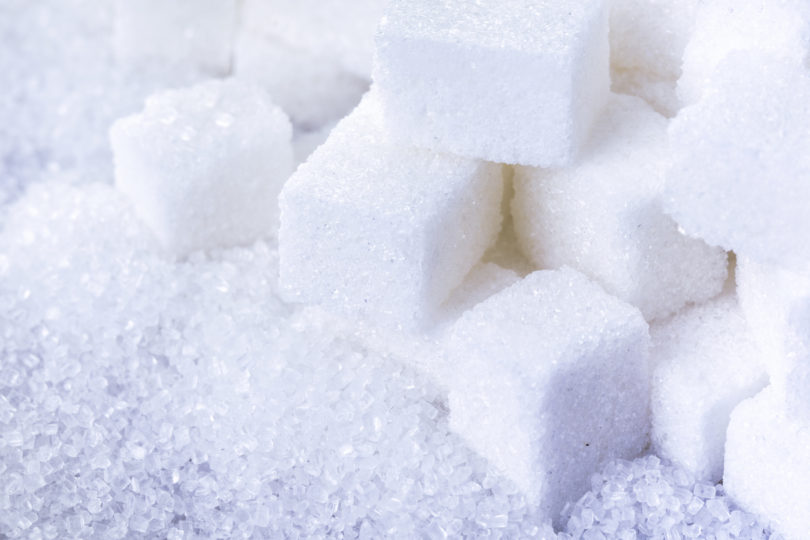The United States consumes more sugar per capita than any other country in the world. In 1999, sugar use peaked — Americans were consuming over 13 pounds of sugar a month. But since the rise of obesity, an increasing number of Americans have been focused on healthier lifestyles. More people are saying no to all types of sugar. Here’s the thing, our bodies need sugar for energy to live. True. But, but, complex carbohydrates are a much better way to go for this type of energy.
3 Types of Sugars to Know
Glucose
Also called blood sugar because it circulates in the blood, glucose is the most convenient form of sugar for our bodies to convert into energy, thus our main source. Glucose is a monosaccharide, or a simple sugar. It can be found in fruits and honey. Most of the carbohydrates we consume are processed by our bodies into glucose. It can be used immediately for energy, transferred to muscle cells, or stored in the liver.
Fructose
A simple sugar found in many fruits and vegetables, fructose is also added to sodas. Unlike glucose, this type of sugar is not a favored energy source for muscles and the brain. Fructose tends to be sneaky because it does not stimulate insulin as well as glucose. Enter high fructose corn syrup (HFCS). Once inside your liver high amounts of fructose can create glycerol, which in turn promotes fat. Be on the lookout for HFCS: it can be found in sugary cereals, soda and cookies.
Sucrose
Sucrose is usually known as simply table sugar. It’s a disaccharide, a combination of glucose and fructose. It’s extracted from sugar cane and sugar beet to make the granulated white stuff we’re so familiar with. Mangoes, pineapples and apricots naturally contain sucrose. It was once widely used in desserts and ice cream but in the last few decades high fructose corn syrup has taken up that crown.
Sugar Bombs to Avoid
If you’re struggling with sugar and your weight here are some things you might want to consider cutting back on, or throwing out altogether.
Soda
Most sodas are loaded with HFCS. Pretty much a no-brainer.
TV Dinners
Although they are not necessarily known for their high sugar content (up to 10 grams), TV dinners still deserve a worthy mention. A lot of frozen dinners are loaded with fat and salt. Some have over 40 percent of the recommended daily value in total fat, over 50 percent of saturated fat and over 70 percent of the recommended intake.
Sweets
Avoid sugary breakfast cereals, cakes, ice cream and candy. Although avoiding sweets is a good modus operandi, a little divergence here and there is okay. Two or three times a week, have a brownie, or a slice of cake, or a small bowl of ice cream. Just stay on top of the numbers. Consider this: one tiny serving of the nation’s best-selling cookies contains over 150 calories, 9 percent of your recommended daily fat intake and 14 grams of sugar.
Sweet Relief
Since most carbs are processed into glucose, our bodies already receive the energy they need. Cokes and lattes, donuts for breakfast — all of that is just added sugar. But there are replacements.
For Coffee
A sugar substitute that has gained popularity in recent years, stevia has a taste that takes a little getting used to. Instead of table sugar in coffee, stir in a couple packets of stevia and just under a tablespoon of Sugar in the Raw. Also check out Zevia as a sugary soft drink alternative. It’s a clear soda (won’t stain teeth) with zero calories and sweetened with stevia instead of sugar.
For Breakfast
Breakfast isn’t so much a replacement as it is a welcome addition. A couple of yogurts and a piece of fruit does the trick for the most important meal of the day. Yogurt is a good protein source, which promotes weight loss and helps curb appetite. Not all yogurts are created equal so choose carefully as some brands can be high in sugar. Fruit can also be good for sugar cravings. Keeping plums, strawberries and grapes handy isn’t a bad idea.
For Anytime
Don’t forget to stay hydrated. Drinking lots of water not only helps flush out toxins but it also burns calories by elevating resting energy expenditure. If you get bored of the taste change it up with something bubbly, like sparkling mineral water — unsweetened of course.
Above all keep in mind no one is perfect. Sugar doesn’t need to be a problem if handled with care. Paying attention to the numbers will give us room to indulge here and there, making that once-in-a-while hot fudge brownie sundae all the more sweeter.


